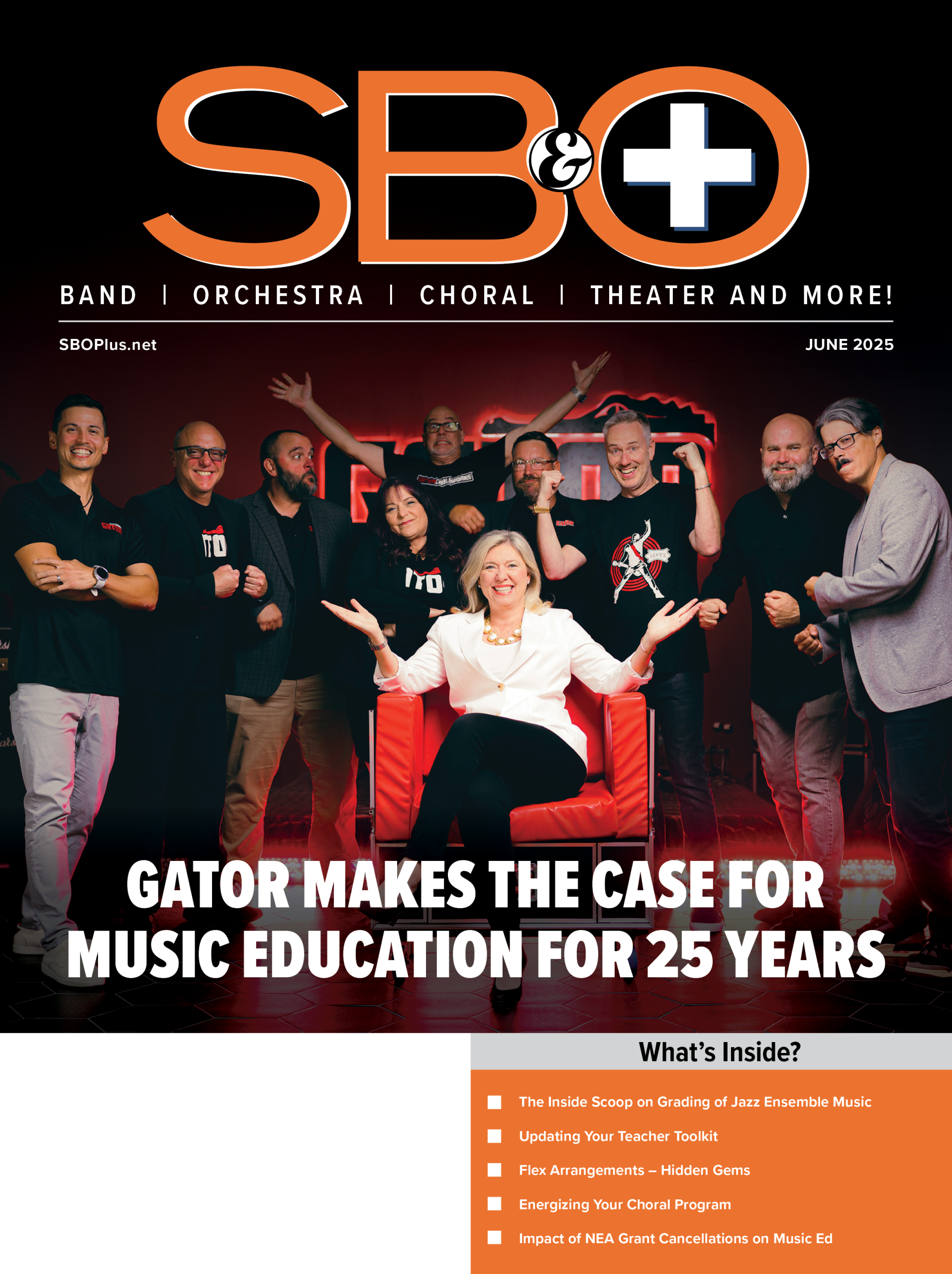When musicians come together to make music in a group, we assume they listen intently. But music-making uses so many mental and physical skills that the ears are often eclipsed.
We can view an object for its color, its texture, its size, its shape, its distance from us, and its dance with positive and negative space, or look directly at it and not consciously notice anything. The same is true for our ears. To transition from involuntary hearing to active listening takes intention and practice. We must activate new auditory perceptions through isolation exercises that involve learning how to activate the brain differently to create multi-level listening. When we do this, it’s as if we’ve discovered a new way of hearing.
Think of the brain as a series of muscles. If one “muscle” is over-used, it will become dominant, which can retard development in the other “muscles.” The body/brain will keep funneling control into the stronger skill; it’s a built-in default system.
By design – or by evolution – vision tends to dominate our other senses. The size of the visual cortex (the part of our brain that manages visual function) is considerably larger than the auditory cortex (the part of our brain that processes sound). Our culture bombards us with visual information through television, computers, and books, further increasing our reliance on sight. Then, as musicians, we keep “working out” the visual cortex when we stand at the music stand “flexing our eyes” in order to make music. All of these factors conspire to dilute the development of our ears.
How do we strengthen our ears to improve our listening skills? Like any muscle you set out to strengthen, the ears must be singled out and exercised on their own. If you focus your ensemble members on listening first, allowing them to warm up the auditory muscle before they even look at the sheet music, you will help their brains to establish a hierarchy that’s more appropriate to the act of making music. This is particularly important if they have just come from a series of classes, driving a car, or staring at a computer. The few minutes you spend re-tuning their brains will be well worth the time because the whole session will be more productive. They will be listening rather than merely hearing.
Here’s a familiar scenario in my studio: While I work mostly with musicians who are interested in learning how to improvise, I also work with classical players on ergonomic (playing healthy) techniques. When I teach these musicians, I sometimes single out a troublesome phrase in the music, and ask them to repeat it a few times with something new in mind (such as breathing, or releasing their thumb, or organizing how they move on their instrument differently). They will inevitably stare at the sheet music and, consequently, don’t carry out the assignment very well.
If I swing the music-stand away from them, they often stumble, searching for the notes. Their first inclination is to use their eyes to organize the activity, by trying to look back at the sheet music. At this point, I force them to establish the phrase through ear training: I play it, they repeat it back. At first they might play awkwardly, but once their brain switches over from their eyes to their ears, there is a tangible moment when the fog lifts, and they truly hear the phrase — possibly for the very first time! At this point we can return to technical coaching on the phrase. They are now much more aware, in general, about body position, use of hands, intended sound, and so on. When we do turn back to the sheet music, we’ve established a different brain-to-ear-to-hand hierarchy, and their tone, as well as their musicianship, will show it for the rest of the lesson.
Following are some additional suggestions and exercises that help develop a listen-first hierarchy.
Removing Visual Stimuli
Removing the musician’s eyes from the process of making music can produce truly astonishing results. You can use a blindfold, turn off the lights, play by candlelight, or ask everyone to close their eyes. Whichever method you use, you will hear a dramatic increase in the group’s musicianship almost immediately. Members of the ensemble will listen more carefully and be more aware of how they use their bodies to produce sound.
Ask students to play the same passage of music, first staring at the sheet music, then at their instrument, and finally, off into the distance. Then turn off the lights or ask them to close their eyes and repeat the passage. You will never be disappointed by the results. The removal of visual stimuli helps create a focused tunnel through which the ears can hone in on not only the details, but also how those details come together to create the whole effect. Players may stumble at first to find their notes, but you can help them by singing or playing the phrase until they have it.
Ear Training
You can use call-and-response exercises to isolate a rhythmic or melodic figure from the music as an ear training warm-up. For instance, choose a problematic passage and either sing, demonstrate (on your instrument), or ask a volunteer to play the first note of the phrase; the group will echo it back, then play the first two notes; the group echoes them back; and so on, until the group has repeated the whole phrase. If, at any point in this process, members of the group don’t repeat the phrase perfectly, you can either simplify it again, or keep giving them that particular portion of the phrase until everyone is confident about the notes and/or rhythms.
This is a great exercise to help the entire ensemble learn one another’s parts, particularly if the music is complex or if they aren’t playing well together as a group.
Listening Exercises
Audiation, the ability to hear the phrase or interval before we play it, is one of the more important listening skills we can help our students cultivate. Whether it’s one by one or all at once, ask your students to choose a melody they know really well (like “Happy Birthday”) and find it on their instrument. Then take a problematical phrase from your repertoire and play it for them slowly, asking them to try to hear the next note (or section of notes) before you actually play it. Encourage them to practice audiating at home.
You can also lead a partner game in which the “audiation specialist” (or whatever playful title you choose) has to anticipate what his/her partner is going to say and echo the partner’s words back as quickly as he/she can. Kids do this all the time when trying to irritate their parents! When you practice anticipating another person’s words and sentences, you have to exercise the same skills we need in music. This exercise will provide lots of fun while deepening your students’ “other ear.”
Just as we can change focus with our eyes, we can refocus our ears on sounds that are far away, or by degree, closer and closer. We can focus on the details of our own sound, or hear the totality of the group. We can also use images to facilitate changes in how we listen.
Ask the players to close their eyes and listen to the sounds around them. Start by bringing their attention to sounds that are outside of the room, and then gradually focus their ears on sounds that are closer and closer, until you ask them to listen to the rustling of clothing in the room, the buzz of fluorescent lights, or their own heartbeats.
Here’s an example of another version of this exercise, requiring a mix of deep listening and imagination:
Tell the players:
Close your eyes and listen to each sound as I describe it:
- The timers on the traffic lights…the grass growing…trees swaying in the wind…people chewing their food in local restaurants…the sounds of the stars emitting light…
- Now focus your ears on the sounds just inside this room…
- Listen to the noise emitted by the lights in the room…the carpet decompressing… the floor boards lifting…your breath…your heartbeat… the blood moving through your veins…
Add or substitute whatever images might be useful to your group.
Recommended Reading
“The Listening Book,” by Allaudin Mathieu (Shambhala Press).
Julie Lyonn Lieberman is an improvising violinist, singer, composer, educator, recording artist, author, and producer. Formerly on faculty at Juilliard, New York University, and The New School University’s Jazz Program, she now teaches privately in her NYC studio. Lieberman has performed on and off Broadway, throughout the U.S., Canada, and in Europe, and has appeared on television and radio.
Lieberman is the author of six books, including “The Creative Band and Orchestra,” “The Contemporary Violinist,” “Improvising Violin,” “Rockin’ Out With Blues Fiddle,” “You Are Your Instrument,” and “Planet Musician.” She has created seven programs for National Public Radio on jazz violin, including the five-part series, “The Talking Violin,” hosted by Billy Taylor, and the two-part series “Jazz Profiles: Jazz Violin,” hosted by Nancy Wilson. She also has five recordings of original music to her credit and has composed for Off-Broadway as well as numerous dance companies. Lieberman has performed her original music throughout the U.S. in concert halls, colleges, and clubs, as well as in Europe and Canada, (including numerous radio appearances throughout).
Lieberman has presented workshops for National String Workshop, International String Workshop, American String Teacher, Suzuki Association, Music Educator’s Association, Texas Orchestra Conductor’s Association, The International Association of Jazz Educators, and colleges and universities throughout the United States and Canada, including Eastman Conservatory, Juilliard, and Manhattan School of Music, to name a few.


























